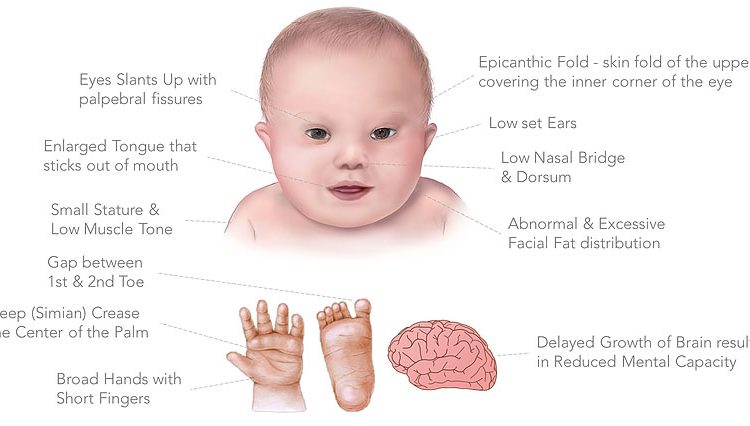Cook- Down Syndrome- Blog 2
Overview of Down Syndrome
Approximately 400,000 Americans have Down Syndrome (Presson et al., 2013). Down syndrome is the most common type of intellectual disability that results from a chromosomal disorder. The most common form of Down syndrome is Trisomy 21, which occurs when each cell in the body creates a third copy of chromosome 21 instead of the average two copies (Facts about, 2023). Trisomy 21 accounts for over 95% of cases of Down syndrome. However, about 3% of people with Down syndrome have Translocation Down syndrome. Translocation Down Syndrome results when an extra chromosome 21 appears translocated to a chromosome other than chromosome 21. Approximately 2% of people with Down syndrome have Mosaic Down syndrome. Mosaic Down syndrome occurs when some cells in the body form a third copy of chromosome 21, while others have the typical two copies of chromosome 21 in each cell. Individuals with Mosaic Down syndrome usually have fewer symptoms of Down syndrome as the condition affects less of their cells. This discussion will primarily focus on Down syndrome in terms of the condition Trisomy 21 and present an overview of the symptoms as well as the impact on development, cognitive skills, and emotions.
Symptoms/Characteristics
How Down Syndrome Impacts Development
Development for a person with Down syndrome follows its own course. Children with Down syndrome show mild deviation from neurotypical developmental goals early on (Grieco et al., 2015). For example, children may show delayed motor and language development. Children are expected to begin talking around 10 months, but a child with Down syndrome may begin talking closer to 16 months. Walking is expected by about a year, but a child with Down syndrome may begin walking around two instead. Delayed motor development can partially be linked to the chances of reduced muscle tone in most children with Down syndrome. As a child nears school age their nonverbal skills will advance and stay on the trajectory, but verbal skills may begin to show apparent deficits with expressive language delays. For example, storytelling may be challenging. Comprehension is unaffected, but deficits in attention and executive function appear in early childhood that can become more pronounced as one gets older. By adulthood, neurodegeneration may begin to occur affecting emotional and behavioral functioning.
Visit the link below for an overview of what to expect while your child is developing and typical developmental goals for them if they have Down syndrome.
Developmental expectations and medical issues for children with Down syndrome
How Down Syndrome Impacts Cognitive Skills
How Down Syndrome Impacts Emotions
A small amount of evidence suggests that Down syndrome can make regulating emotions difficult for some people, but the topic is still up for debate as there is not enough information yet to understand how Down syndrome affects emotional competence (Sideropoulos et al., 2023). It is clear that some children with Down syndrome have emotion regulation problems with high rates of frustration. Previously, theorists have suggested that adolescents with Down syndrome have difficulty recognizing emotions, but recent research indicates that there is no support for such claims (Pochon et al., 2017). Children may show emotional deficits when verbal tasks are used to recognize emotions as individuals with Down syndrome have trouble processing verbal information and tasks, but not when nonverbal tasks are used. However, Andres-Roqueta et al. (2021) suggested that adults with Down syndrome may have difficulty understanding emotions and processing them. Negative emotions in particular are thought to be difficult for some people with Down syndrome to process. Even so, most individuals with Down syndrome are very sociable, and social functioning is considered a major strength for them (Naess et al., 2017). Every person is different though, so this information should not be used to perpetuate any stereotypes or form false assumptions.
References
Andrés-Roqueta, C., Soria-Izquierdo, E., & Górriz-Plumed, A. B. (2021). Exploring different aspects of emotion understanding in adults with Down Syndrome. Research in Developmental Disabilities, 114, 103962. https://doi.org/10.1016/j.ridd.2021.103962
Asim, A., Kumar, A., Muthuswamy, S., Jain, S., & Agarwal, S. (2015). Down syndrome: An insight of the disease”. Journal of Biomedical Science, 22(1). https://doi.org/10.1186/s12929-015-0138-y
Channell, M.M., Mattie, L.J., Hamilton, D.R., Capone, G.T., Mahone, E.M., Sherman, S.L., Rosser, T.C., Reeves, R.H., & Kalb, L.G. (2021). Down syndrome cognition project. Capturing cognitive and behavioral variability among individuals with Down syndrome: a latent profile analysis. Journal of Neurodevelopmental Disorders, 13(1).https://doi.org/10.1186/s11689-021-09365-2
Developmental expectations and medical issues for children with Down syndrome. (2020). National Down Syndrome Congress. https://www.ndsccenter.org/wp-content/uploads/MilestonesMed-Issues.pdf
Facts about down syndrome. (2023). Centers for Disease Control and Prevention. https://www.cdc.gov/ncbddd/birthdefects/downsyndrome.html
Gigi's Playhouse Inc. (2022, January 26). Down syndrome 101 | What it's like to have Down syndrome [Video]. YouTube. https://www.youtube.com/watch?v=nvytGXnpFaY
Lott, I.T., & Dierssen, M. (2010). Cognitive deficits and associated neurological complications in individuals with Down's syndrome. Lancet Neurology, 9(6),623-33. https://doi.org/10.1016/s1474-4422(10)70112-5
Marini, I., & Stebnicki, M. A. (2018). The psychological and social impact of illness and disability, (7th ed.). Springer Publishing.
Næss, K.B., Nygaard, E., Ostad, J., Dolva, A.S., & Lyster, S.H. (2017). The profile of social functioning in children with Down syndrome. Disability Rehabilitation, 39(13),1320-1331. https://doi.org/10.1080/09638288.2016.1194901
[Photograph of baby playing]. (n.d.). https://www.noldus.com/static/images/core-blog/cognition-infants-down-syndrome.jpg
[Photograph of baby with Down syndrome]. (n.d.). https://www.punekarnews.in/down-syndrome-things-parents-need-to-know/
[Photograph of brain of person with Down syndrome]. (n.d.). https://www.thelancet.com/cms/attachment/2000992345/2003665440/gr1.jpg
Pochon, R., Touchet, C., & Ibernon, L. (2017). Emotion recognition in adolescents with Down syndrome: A nonverbal approach. Brain Sciences, 7(6). https://doi.org/10.3390/brainsci7060055
Presson, A. P., Partyka, G., Jensen, K. M., Devine, O. J., Rasmussen, S. A., McCabe, L. L., & B. McCabe, E. R. (2013). Current estimate of down syndrome population prevalence in the United States. The Journal of Pediatrics, 163(4), 1163. https://doi.org/10.1016/j.jpeds.2013.06.013
Sideropoulos, V., Sokhn, N., Palikara, O., Van Herwegen, J., & Samson, A. C. (2023). Anxiety, concerns and emotion regulation in individuals with Williams syndrome and Down syndrome during the COVID-19 outbreak: A global study. Scientific Reports, 13(1), 1-14. https://doi.org/10.1038/s41598-023-35176-7



Comments
Post a Comment